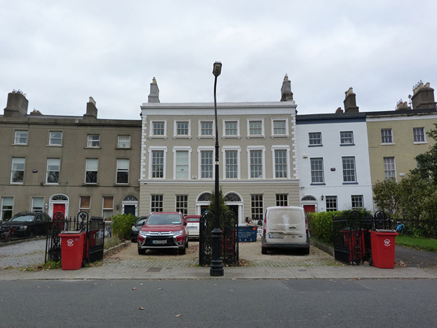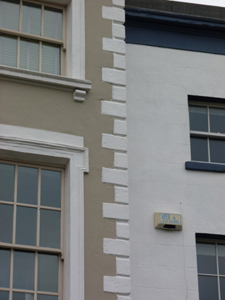Survey Data
Reg No
50120110
Rating
Regional
Categories of Special Interest
Architectural, Artistic
Original Use
House
In Use As
House
Date
1790 - 1795
Coordinates
318006, 236462
Date Recorded
02/11/2017
Date Updated
--/--/--
Description
Terraced three-bay two-pile three-storey house over raised basement, built 1792 as one of twenty-five and as pair with house to east, being higher than rest of terrace and having projecting rear elevation, latter with return. M-profile pitched slate roof, hidden behind rendered parapet with moulded render cornice, and eaves course, having rendered chimneystacks with clay pots to east end and angled stack to rear, and with hipped roof to return. Rendered walls to upper floors with raised block-and-start quoins to west end, over channelled rendered ground floor walling having cut masonry plinth course above rendered basement walling. Square-headed window openings with rendered architraves to upper floors, lugged and with rendered sill course to first floor, and rendered sills supported on moulded corbels to ground and second floors. Replacement timber sliding sash windows to front elevation, three-over-three pane to top floor and six-over-six pane elsewhere; round-headed stairs window and square-headed timber sash windows apparent to rear elevation. Round-headed doorway with moulded render surround, carved stone doorcase comprising Doric columns supporting frieze, stained-glass petal fanlight and timber panelled door, approached by two nosed granite steps and platform with decorative cast-iron railings. carparking to former front garden, bounded to footpath by decorative cast-iron piers and vehicular gate. Garden to rear.
Appraisal
This house forms part of the centrepiece of a significant architectural set-piece, Marino Crescent, one of the few Georgian crescents in the city. A higher level of ornamentation is evident in this house and its neighbour to the west, with stucco detailing, channelled render to the ground floor, architraves to the window openings of the upper floors, and prominent moulded cornices. The fine Doric doorway with its hand-painted leaded fanlight provides the decorative focus to the ground floor. The crescent comprises houses of similar parapet heights and fenestration patterns, having larger houses to the centre and west end, including this house. The crescent was built in the last decade of the eighteenth century to take advantage of the sea views, prior to land reclamation projects associated with the enlargement of Dublin Port. The houses were built by Charles ffolliot, reputedly to spite Lord Charlemont, blocking the vista from Marino House, and were locally known as Spite Crescent as a result.













